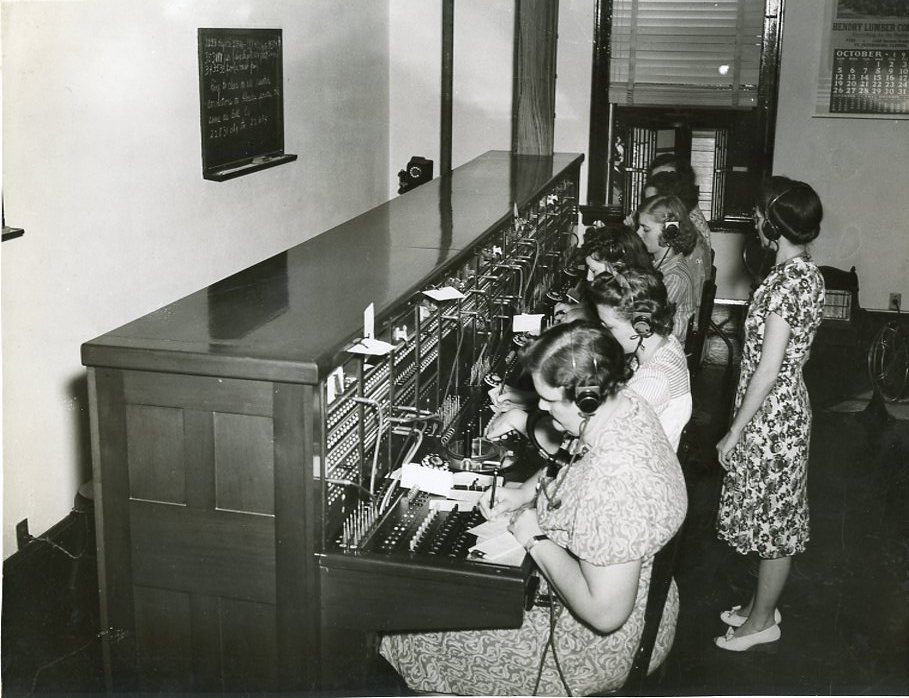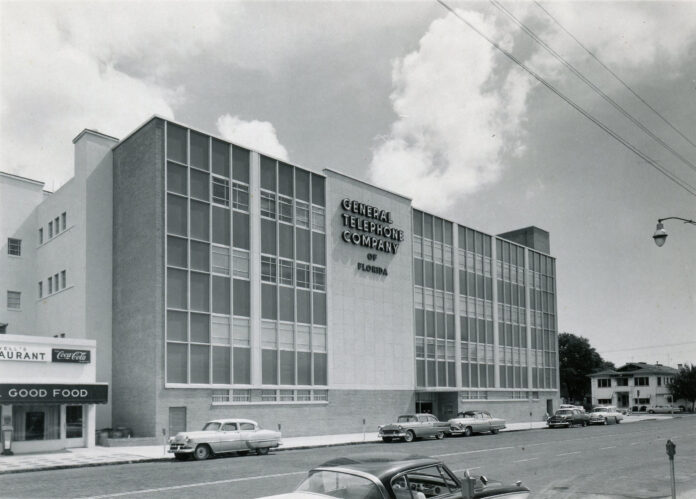At 821 First Ave. N, between 8th and 9th streets, looms a mysterious, hulking building. An odd mix of brick and metal with virtually no windows, its form gives a clue to its function. What’s the story of this boxy behemoth?
Built in 1925 for the Peninsular Telephone Company (known as West Coast Telephone until 1923), the building’s mammoth size was necessary to house the massive batteries and equipment required to operate the revolutionary new “automatic dial” system that was installed in the fall of that year. Powered by the Strowger Switch, the automated system eliminated the need for the “Hello Girl” – the operators that had heretofore connected every single call placed throughout the city. By the opening of the new building in September 1925, some 15,000 dial telephones would be installed in the city, a five-fold increase from the number of phones in use just two years prior. Half of the lines were to be party lines, with up to 10 phones connected to each, making for plenty of wonderful opportunities to eavesdrop on one’s neighbors.
The Strowger Switch
If the Hello Girls wished to lodge a complaint about the newfangled Strowger Switch that displaced them, they wouldn’t need to go far to harangue its inventor. He was buried just a mile away in Greenwood Cemetery. In the type of coincidence that could happen only in a resort city like St. Petersburg, the inventor of the Strowger Switch, the gadget that enabled the creation of an automatic dial-telephone system, had moved to town in the 1890s and died here in 1902.

Almon Brown Strowger came up with the idea for the switch as a desperate measure to protect his career. A Civil War veteran who fought for the Union in the Battle of Bull Run, Strowger went on to become an undertaker in Kansas City. He was convinced that his competitor’s wife, an operator at the local telephone company, was intercepting phone calls to Strowger’s mortuary business and relaying them to her husband’s funeral home instead. He sought a way to eliminate the middleman (a woman, in this case) from the connection of the phone call. Mechanically inclined, he designed his contraption using some straight pins and the round box used to store his shirt collars. Strowger patented his invention in 1892, but its usefulness wasn’t immediately clear to the phone companies. He sold the patent after a few years for just $1,800. After its popularity grew, it would sell again, 15 years later, for $2.5 million, to Bell Telephone Systems. Meanwhile, Strowger moved to St. Petersburg in the late 1890s and took up his old career, working for the H.P. Bussey Funeral Home. Strowger died in 1902 and is buried at Greenwood Cemetery on Dr. Martin Luther King Street S. A bronze plaque was placed at his gravesite in 1949 by members of the telephone industry to commemorate the significance of his invention. The Strowger Switch remained in use until the 1970s.
The construction of the Peninsular Telephone building in 1925 signaled the swan song of the Hello Girls, once cherished for their delightful voices and the personal connection they brought to each telephone call. Now callers would insert their own fingers into holes on new dial telephones, rotate the dial to the desired numbers, and wait in silence for a connection. Callers would speak to an operator only if they were placing a long-distance call or had a problem that warranted a supervisor’s intervention.

The Building’s Saga Continues
The gargantuan building at First Avenue N continued to serve Peninsular Telephone until 1957 when ownership transferred to the General Telephone Company. The building was the site of picket lines during a major strike against General Telephone in 1963 when nearly 3,000 members of Florida Local 824 of the International Brotherhood of Electrical Workers AFL-CIO took part in a 59-day strike protesting salaries, seniority rights, and rules for employment of part-time workers.
In 2000, General Telephone merged with Bell Atlantic to become Verizon, and later, Frontier Communications. The building at First Avenue N was purchased by an LLC out of New Jersey in 2021, and its future is unclear. A quarter of the building is still used by Frontier Communications, with the remaining office space currently unoccupied. While its fate is uncertain, the next time you drive by the building, think of its past with the Hello Girls, Almon Strowger, and the 1963 General Telephone strike.



